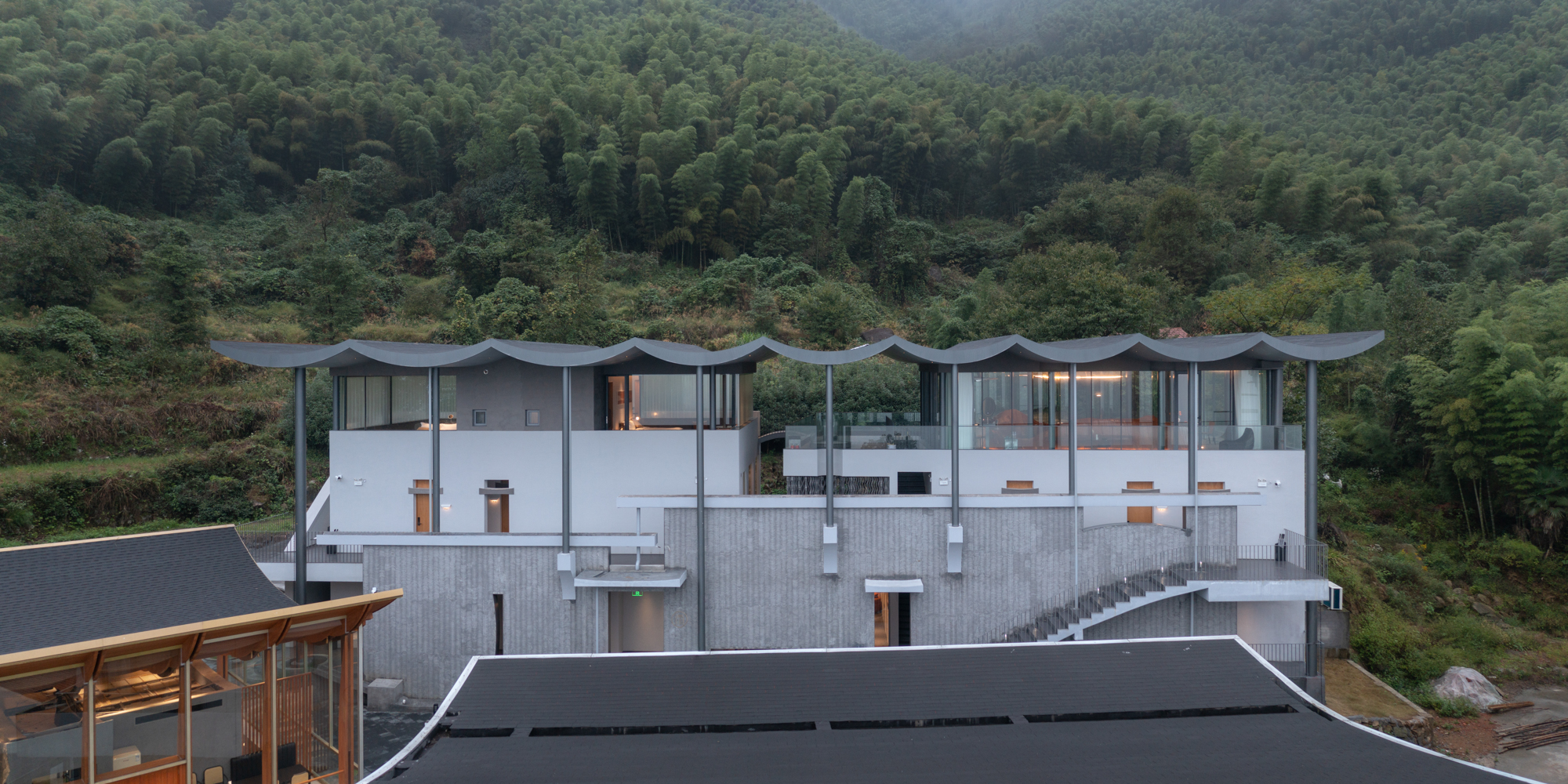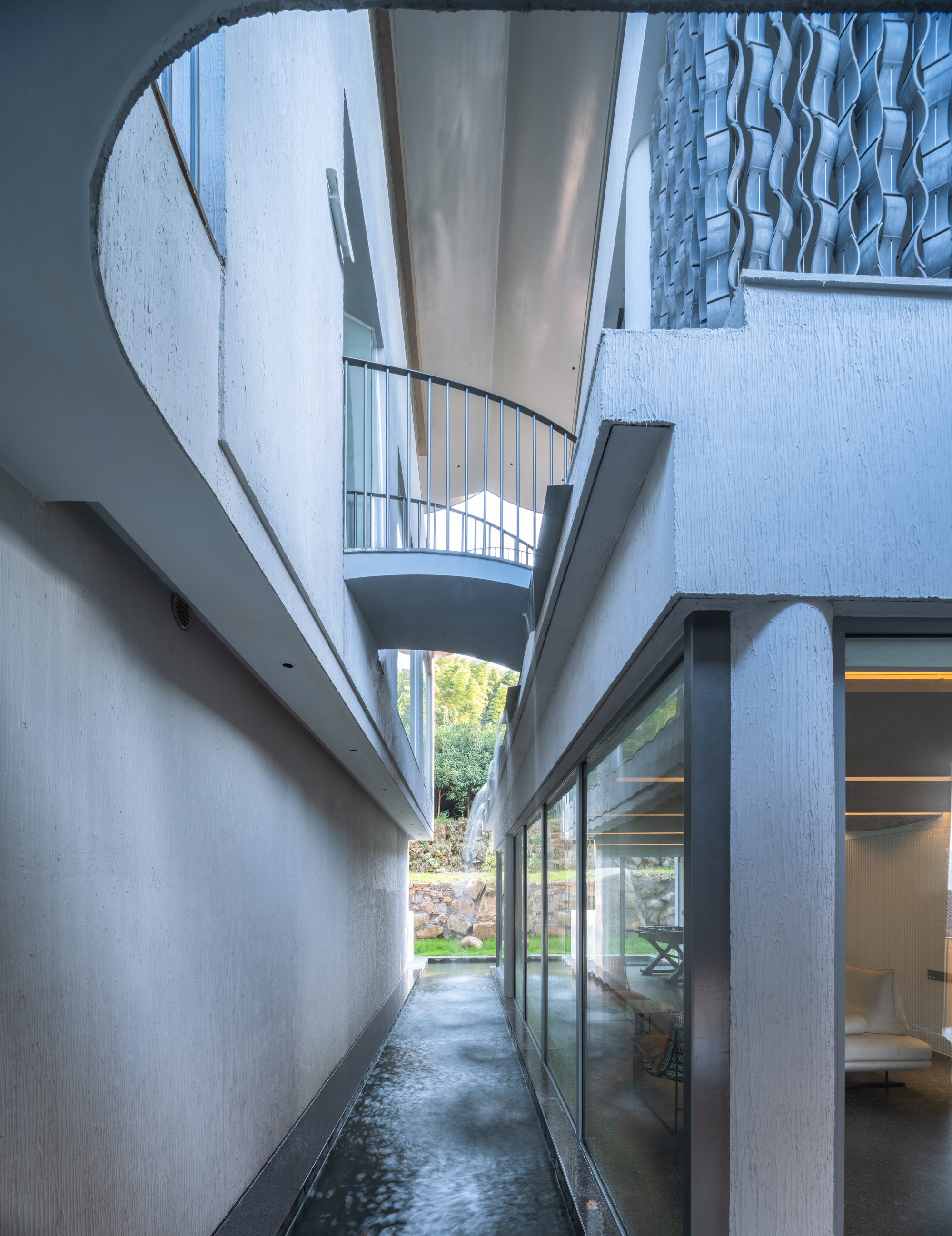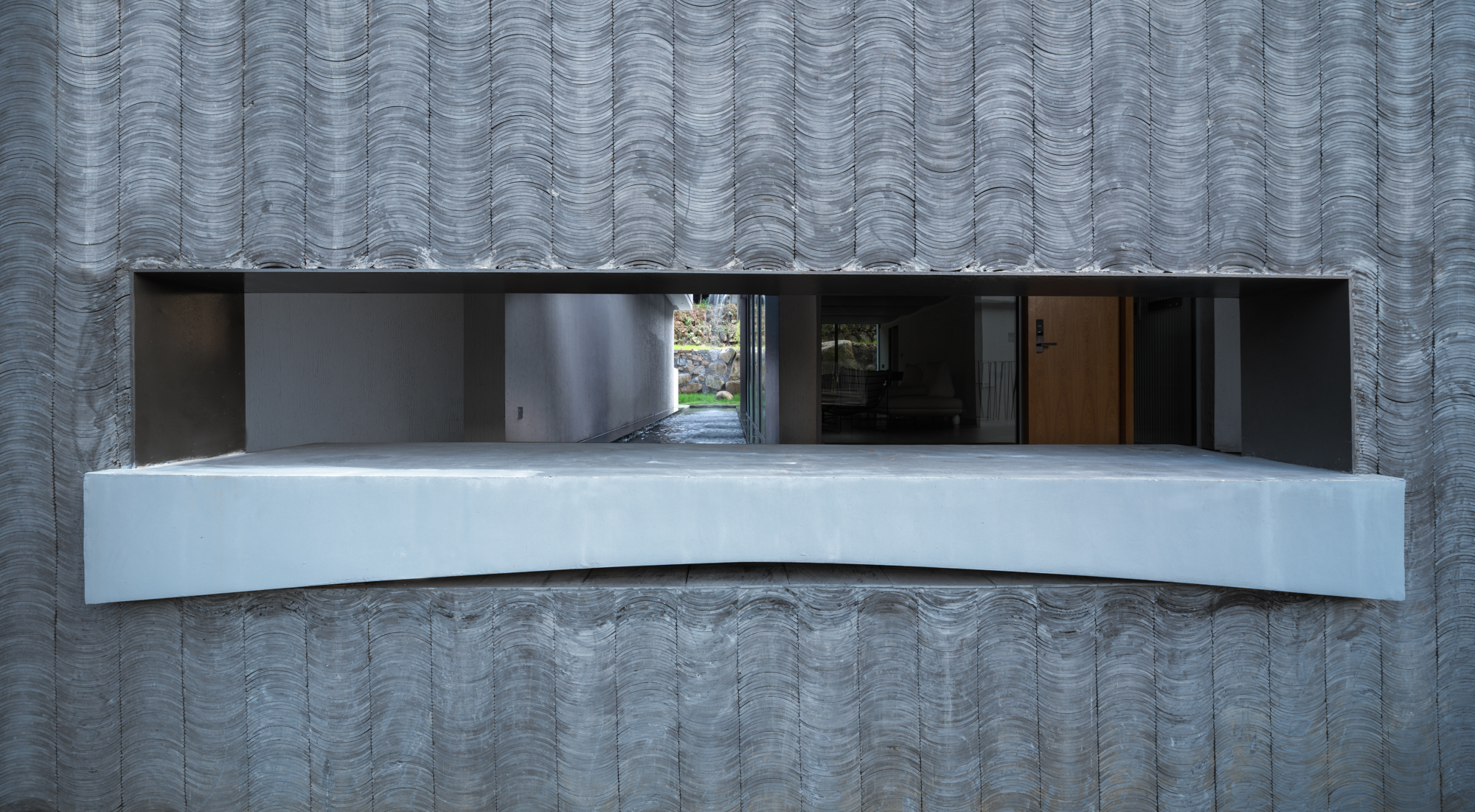
设计单位 来建筑设计工作室
地理位置 浙江杭州
建成时间 2021年10月
建筑面积 1081.63平方米
屋顶是建筑与天空的连接,是空间重要的庇护,也是建筑的核心要素。屋顶的形式逻辑被两个自然要素所左右——重力和雨水。重力作为恒久存在的万物法则,雨水则作为时刻变化的自然之物。与重力的抵抗、与雨水的疏导,决定了屋顶的形式演变。
The roof is the connection between the building and the sky, an important shelter of the space, but also the core element of the building. The formal logic of the roof is influenced by two natural elements, gravity and the rain. Gravity is known as a permanent law of all things, however, the rain is known as a natural thing that changes all the time. The resistance to gravity and the dredging of the rain determine the evolution of the roof.


随着现代材料和力学的发展,自然要素不再是屋顶形式的主导,建筑显现出一种强大无比的人力结果,变得越来越像机器,形体的几何纯粹性和形式的手工操作感(切割、扭转……)展现着现代人的野心。我们对于建筑的哲思并非如此,建筑不是对自然驱赶,而是天人合一的互相接纳——对自然的狂野进行顺导,对自然的生机尽心呵护。
With the development of modern materials and mechanics, natural elements are no longer dominant in the form of roofs. Architecture shows an incomparably powerful human result, becoming more and more like a machine. The geometric purity of the form and the sense of manual operation of the form (cutting, twisting…) demonstrate the ambition of modern people. Our philosophy of architecture is not like this. Architecture is not to drive away nature, but to accept each other in the unity of man and nature: to guide the wildness of nature and to take good care of the vitality of nature.



雨,是因重力落下的水;而水,既无形又有形,既柔软又强力。容器可以刻画水的形状,重力可以推动水的力量。水的顺导是对重力动态的刻画,容器般的建筑则是对重力静态的塑造。一静一动,被牛顿精简成公式的万有引力,因建筑能够呈现出多种推演的证明。
Rain is water falling by gravity. Water is both invisible and tangible, soft and strong. Containers can depict the shape of water, and gravity can push the force of water. The conduit of water is the portrayal of the dynamics of gravity, while the container-like architecture is the static shaping of gravity. A stillness and a movement, condensed by Newton to the law of universal gravitation, is enabled to present a variety of deductive proofs because of architecture.



雨屋位于远离城市的半山之中,周围被竹林和农田环绕。两座分开的村宅用一片大屋顶覆盖。屋顶被圆柱撑起,雨水得以多种方式和路径导向地面,形成一种无形和有形的对仗。于此,我们称之为顺水六式:
Roof III is located in the middle of the mountain far from the city, surrounded by bamboo forests and farmland. The two separate village houses are covered with a large roof. With the roof propped up by columns, rain can lead to the ground in a variety of ways and paths, forming an invisible and tangible confrontation. Here, we call it the six types of taming water:



举水:将屋顶高高举起,或从地面挺立或从墙边承托,水波形连续的屋顶是导水的容器,将原本均匀落下的雨滴汇聚成线性的水路。
Lifting water: To hold the roof high, either by standing up from the ground or being supported from the wall, the continuous water-wave roof is a water-guiding container that converges raindrops that fall evenly into a linear waterway.



川水:水路沿竖直方向奔涌而下,形成最有力量的疏导。“水滴石穿”是描述水力的古老形象。而在设计中则是让水路向下洞穿混凝土板,让水之力得以显形。
Running water: Water rushes down in a vertical direction, forming the most powerful dredging. "Dripping water wears away the stone" is an ancient saying describing water power. The waterway is designed downward to allow water to penetrate the concrete slab, so that the force of water can be manifested.



引水:反曲形水渠,渠之形即为水之形,渠之向引水而去。
Diverting water: Curvy canal, the form of the canal is the form of the water, and the canal leads the water away.

散水:水从半层屋顶直接沿屋檐散落,跌入水塘之中,这种最质朴的落水方式是自由释放的水的原始形态。
Releasing water: Water falls directly along the eaves from the half-story roof and falls into the pond. The most austere way of water falling is the original form of freely released water.


踏水:在建筑二层,路径必经之处要穿过一处水塘,水塘中圆形的汀步需要备好步伐跨越而过,如同雨天在野地里避开水坑的踏水而行。
Treading water: On the second floor of the building, there is pond which is unavoidable along the path. You have to be well-prepared to stride across the circular steps in the pond, just like avoiding puddles when walking in the field on a rainy day.



跨水:桥是富有诗意的人造物,充当着连接和跨越的角色:越涧、越塘、越层,是空间与身体层面的线性连接。在雨屋的顶层,有一间四面通透的大山亭,在屋中,实现远山和身体连结。在檐下,于心中,留给来者一片山水。
Crossing water: The bridge is a poetic artifact, connecting and spanning: crossing the stream, crossing the pond, crossing the floors, and finally, forming a linear connection between the space and the body. On top of the Roof III, there is a big mountain pavilion, open on four sides. In the room, you can connect your body to the far away mountains; under the eaves, you can keep the beautiful scenery in your heart.


2016年设计的“川房”,将金属落水管坦白的表露在建筑外立面,来形成“川流而下”的关于水的隐喻,是团队第一次试图探讨重力与雨水的显形表达。“雨屋”则是对于重力和雨水的进一步探讨,不只是形式的“显露”,更是在践行一种对于自然的精心干预:“欲取之,先集之;欲驯之,先顺之。”
“Chuan Fang”, designed in 2016, frankly reveals the metal plumbing on the facade of the building to form the metaphor of water "flowing down". It is the first attempt to explore the explicit expression of gravity and the rain. " Roof III " is a further discussion of gravity and the rain, not only the "revelation" of form, but also the practice of a careful intervention in nature: "if you want to take it, free it first; if you want to tame it, you must obey it first."





施工照片 ▽





模型 ▽



完整项目信息
项目名称:雨屋
业主:桐庐·未迟·千山精品民宿
设计方:来建筑设计工作室
项目类型:民宿酒店
地理位置:浙江省,杭州市,桐庐县,合岭村
主持建筑师:马岛
项目建筑师:樊宇
设计团队:樊宇、廖启贤、张莹
摄影:赵奕龙、唐徐国、樊宇
结构:钢筋混凝土框架结构&钢结构
用地面积:412.61平方米
建筑面积:1081.63平方米
设计周期:2019年9月—2020年12月
建设周期:2019年10月—2021年10月
版权声明:本文由来建筑设计工作室授权发布。欢迎转发,禁止以有方编辑版本转载。
投稿邮箱:media@archiposition.com
上一篇:乐清市荆山公学:转译书院空间序列 / 浙江大学建筑设计研究院
下一篇:红盒子:为乡村自建房赋予新表情 / 艾克建筑